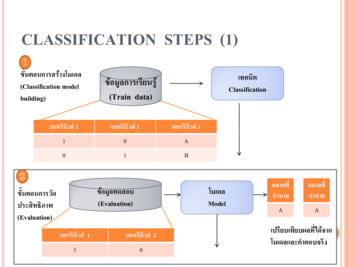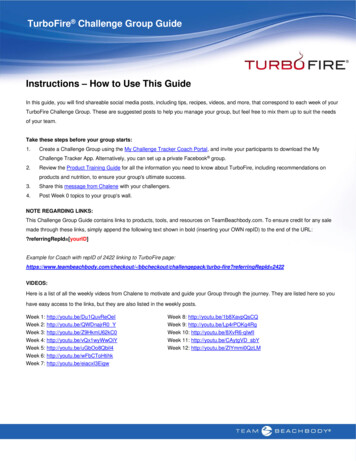
Transcription
BEST IN CLASS: HOWENTERPRISES SUCCEED WITHLANGUAGE-LEARNING PROGRAMSIN ASSOCIATION WITH:
TABLE OF CONTENTSEXECUTIVE SUMMARY . . . . . . . . . . . . . . . . . . . . . . . . . . . . . . . . . . . . . . . . . . . . . . . . . . . . . . . . . . . . . . . . . . . . . . 3KEY FINDINGS . . . . . . . . . . . . . . . . . . . . . . . . . . . . . . . . . . . . . . . . . . . . . . . . . . . . . . . . . . . . . . . . . . . . . . . . . . . . . 4THE CURRENT STATE OF ENTERPRISE LANGUAGE LEARNING . . . . . . . . . . . . . . . . . . . . . . . . . . . . . . . . . . 4BEST PRACTICES . . . . . . . . . . . . . . . . . . . . . . . . . . . . . . . . . . . . . . . . . . . . . . . . . . . . . . . . . . . . . . . . . . . . . . . . . . . 7CONCLUSION . . . . . . . . . . . . . . . . . . . . . . . . . . . . . . . . . . . . . . . . . . . . . . . . . . . . . . . . . . . . . . . . . . . . . . . . . . . . . . 16SOURCES. . . . . . . . . . . . . . . . . . . . . . . . . . . . . . . . . . . . . . . . . . . . . . . . . . . . . . . . . . . . . . . . . . . . . . . . . . . . . . . . . . 17
EXECUTIVE SUMMARYWith more companies entering the global economy, employee languagetraining is gaining force as a valuable contributor to international businesssuccess.Forbes Insights and Rosetta Stone surveyed over 200 executives aroundthe world to find out how leading companies are training their employeesto speak and work in languages—other than their native tongue—and theimpact it is having at an individual and organizational level.The survey reveals that while companies understand the necessity oflanguage learning, incorporating it into the corporate culture remains achallenge.This report identifies success factors for integrating language training intothe business model.3 BEST IN CLASS: HOW ENTERPRISES SUCCEED WITH LANGUAGE LEARNING PROGRAMS
KEY FINDINGSSuccessful learning aligns with organizational goalsMeasuring language learning is key to proving alignment with a company’s strategy. Companies thatbuild language training into employee development plans and track KPIs are twice as likely to successfully link language-learning goals to the organization’s strategic priorities.Language learning positively impacts employeesEmployees who participate in language learning, have greater confidence, improved performance, andincreased engagement in work.Current state of language learning is ripe for disruptionThe proliferation of online learning is prompting organizations to rethink traditional approaches tolearning and adopt technology-facilitated models for training and development.Companies are under-serving their employeesThe vast majority of companies recognize the importance of having multilingual employees across multiple functions and business lines, yet most companies have invested in language learning for less thana quarter of their employees. It is time for language acquisition to expand within companies.THE CURRENT STATE OF ENTERPRISELANGUAGE LEARNINGToday there is a growing acknowledgement of the benefits of second language acquisition byemployees. Companies know that expanding their operations and influence globally requires aworkforce that can communicate effectively in multiple languages. As they work toward this goal,companies are looking for ways to demonstrate that an investment in language learning is a productiveuse of resources. “Language learning takes time and effort, so it’s important that everyone worktogether to set specific learning objectives and make it successful,” says John Hass, CEO of RosettaStone.English is considered the lingua franca of the business world—it tops the list of languages learned inbusinesses internationally. In the U.S., 79% of the population1 is monolingual, where English is the onlylanguage spoken at home, and Canada follows suit with a similar trend: 66% of the Canadianpopulation2 speaks only English. Interestingly, just over half of North American companies train theiremployees in English.1Language Use in the United States: 2011, U.S. Census Bureau, Report Number: ACS-22, August 2013; s/acs-22.html2Linguistic Characteristics of Canadians, Statistics Canada, Catalogue no. 98-314-X2011001, October 2012; /as-sa/98-314-x/98-314-x2011001-eng.cfm#a3 COPYRIGHT 2017 FORBES INSIGHTS 4
In Latin America, most native speakers speak Spanish or Portuguese. To keep up with globalization,almost all companies in this region (97%) have included English in their language-learning programs.Portuguese is the second most popular language taught, given Brazil’s importance in Latin America.Globally, Spanish is frequently one of the top four languages taught in the corporate environment, withGerman and French ranking in the top five languages in all regions. Asia-Pacific has a slightly differentfocus; following English, French, and German, Japanese and Cantonese round out the top five languages. With fertile emerging markets developing throughout the Asia-Pacific region, this is not unexpected.Which languages has your organization used language learning for?OverallNorth AmericaEuropeAsia-PacificLatin 0%9%3%Bengali1%0%0%3%0%5 BEST IN CLASS: HOW ENTERPRISES SUCCEED WITH LANGUAGE LEARNING PROGRAMS
This brings to light the increasing vitality of other languagesand over time may challenge the notion of English as thelingua franca. Companies do recognize the clear need forlanguage training. “Communication in different languagesis expected at NetApp,” says Anna Schlegel, author ofTruly Global and head of globalization and informationengineering at NetApp. “Our CEO is very culturally aware.My team includes people from 22 different countries andbetween us we speak more than 30 languages. Andbecause we evangelize about globalization, the languageskills of my team need to be impeccable.”Very few companies surveyed have significant numbers ofmultilingual employees. Two thirds report that less than50% of their employees have professional proficiency inmore than one language. Thirty-six percent report havingless than one in 10 multilingual employees.Disparity exists, with almost half of the companies admittingthat at least a quarter of their employees should belearning another language. Almost three quarters reportthat less than 25% of their employees have participated inlanguage training at the company.Language and cultureLearning a language is more than expressing yourselfusing the proper grammar and vocabulary; it also involveslearning about societal behaviors and cultural norms.Intercultural communications is at greater risk ofmisunderstanding, if the larger framework of cultureincluding world view, context, and other auxiliarycommunication elements are ignored.“Companies know they have a communication needacross cultural divides,” says Dr. Richard Brecht, executivedirector of American Councils Research Center at theAmerican Councils for International Education inWashington, D.C. “But they may be focused on just thelanguage and not the value of the language with regard tounderstanding the culture.” COPYRIGHT 2017 FORBES INSIGHTS 6
“Companies want people who can communicate in multinational teams in different languages,” says Dr.Ben Voyer, L’Oréal professor of creativity marketing at ESCP Europe Business School in London. “Thisshows that people are prepared and capable of understanding the viewpoint of others. For example,there are certain words that are only in some languages, and certain emotions may be more prevalentin some languages.”In the business world, whether you are operating nationally or internationally, communication is the keyto success, but when operating internationally it becomes even more important due to languagebarriers. Miscommunication could have a direct impact on expansion and profitability. An unsuccessfulinteraction with a customer could end a relationship. A failed conversation with a supplier or key partnercould have serious financial or strategic implications.In the past five years the call center industry has become an important part of the labor market in theU.S., India, and the Philippines. Call center agents must have excellent language skills. Agents withlimited skills in areas such as active listening or pronunciation can cause customer frustration, resultingin lost customers and billing errors. “The focus now is really on being able to get the message and thecontext as early as possible, to lower customer effort and to have a meaningful conversation,” saysGeorge Ramos, AVP for learning and development at Teledevelopment.SUCCESS FACTORSAs with any new initiative, alignment with company goals is critical to success. This is especially the casewith a valuable skill like language learning. Support from the top ranks of executives is also vital toproperly align training to the company’s strategic goals.Alignment with organizational goalsOver half of the companies in this survey (64%) feel reasonably confident that they are able to alignlanguage-learning programs to the company’s strategic direction and that they provide meaningfullearning opportunities through language for employees, even if those opportunities do not directlypertain to their job or the company’s business objectives.7 BEST IN CLASS: HOW ENTERPRISES SUCCEED WITH LANGUAGE LEARNING PROGRAMS
There is a gap here, between the confidence companiesare expressing in their ability to align strategy andlanguage learning and the reality of their multilingualworkforce. Most report that less than half of theirworkforce has professional level proficiency in more thanone language, and that less than a quarter of employeeshave participated in language training at the company. Isthis overconfidence in the ability to connect this type oftraining with the company’s strategic direction? Or does itsimply reveal the natural limits of a multilingual workforce?Few, if any, companies need greater than 90% of theworkforce to be proficient in more than one language. Infact, only 17% had those expectations.While most companies have a reasonable level ofconfidence in their abilities to align to larger businessobjectives, one in 10 reports complete alignment of alanguage-learning program to the company’s strategicdirection. This indicates that they consider themselves aglobal company and to achieve their objectives they needall employees to be able to effectively communicate withcoworkers, customers, and suppliers throughout theworld.Evidence points to formally encouraging and measuringlanguage-training programs as the way to align trainingand organizational goals. Companies that build languagelearning into employee development plans and track keyperformance indicators (KPI) to measure their success aretwice as likely to report complete alignment.What is working for the companies that are able to alignstrategic direction with language learning? Simple, thebusiness requires it. These companies cite strong globalvision and significant presence in markets or geographiesthat require employees with multilingual competencies assuccess factors.What stops companies from aligning to their strategicdirection? Lack of global vision or a perceived lack of needfor multilingual employees, because the company is not inmarkets or geographies that require those skills. COPYRIGHT 2017 FORBES INSIGHTS 8
For these companies, this near-sightedness could present challenges in the future such as limitingopportunities for expansion into new markets or making them less competitive in their existing markets.In addition to alignment with the mission, the other factor that enables companies to have a successfullanguage-learning program is support from senior management. “A company has to do more than offerlanguage learning,” says Hass. “They have to communicate to employees that the training is important.And employees have to understand why management is implementing the program and what theybelieve can be achieved.”That is a key takeaway for management teams. Language training is not to be entered into lightly orbecause it seems like the right thing to do. Management must understand how language training fitswith the company’s goals and exactly why they want employees to learn a language.“Make sure employees understand what you want them to learn,” says Voyer. “Learning a language,going from beginner to fluency, requires a lot of work. Fundamentally there is one thing that isessential—motivation to learn. If students are forced to learn or are forcing themselves, really quicklythey hit a wall. You can’t learn a language like you learn facts.”Language's Effect on the WorkforceWhen deciding who gets to learn a language, only a small number of companies expect all employeesto have second language skills as a core competency. Given that English is the prime language ofglobal business, North American companies are least likely to consider multilingualism as core to theirstrategy and success for their entire workforce.Language Training for AllKnowledge of morethan one language isa core competencyexpected of all ormost employeesOverallN AmericaEuropeAsia-PacificLatin America17%9%18%24%22%Most companies assess language needs on a case-by-case basis, taking into account organizationalgoals, assessed needs, and future expansion plans. Two-thirds of the companies surveyed report thatall of their employees are theoretically eligible for language training. Though, in general, the decisionabout who gets training is based on the roles and responsibilities of the individual employees. And thatdecision is made by those in the company who must conduct some business transactions in otherlanguages, like management or customer service teams. In most companies, supervisors and managersnominate employees for training, or they allow employees to self-identify.9 BEST IN CLASS: HOW ENTERPRISES SUCCEED WITH LANGUAGE LEARNING PROGRAMS
Motivation is a critical factor in enabling someone to learna new language. And it can be a challenge. “It would begreat if language were easily learned. But there is no wayaround it,” says Brecht. “There is no shortcut: it takes timeand effort. The biggest obstacle with individual learners ismotivation. How can programs keep them motivated andon track. Motivation for language learning for business canbe strong, if the employee understands the key role oflanguage ability in providing access to different culturesand countries.”When it comes to learning in the workplace, employeesare primarily motivated to learn a language to improvetheir communications confidence, to earn a promotion oradvance their careers, and to improve productivity.Motivation is an important factor in achieving long-termsuccess, but learning a new language presentschallenges. One is keeping motivation at a high level allthe time. The learner must understand why they need tomake an effort, how long they must sustain an activity, howhard they should pursue it, and devise an action plan onhow to achieve those goals. Effective engagementstrategies must be implemented to achieve success in anyemployee development program.No surprise that lack of time is the biggest challenge foremployees in this regard. Just over half of the executivessurveyed cite lack of work time and non-work time todevote to learning and practice as an obstacle. The thirdbiggest challenge for employees is one familiar to manywho have considered studying another language: generalfear of learning a language.While that fear is real for all learners, there is additionalpressure in a business setting—that of tying successcommunicating in a new language to the employee’scareer success. Thus, it is important for companies toquantify success in learning a language and make thegoals clear from the beginning. Is it complete proficiencyand passing exams? Is it the ability to understand basicconversations or written communication? Is it to build trustwith suppliers and partners? COPYRIGHT 2017 FORBES INSIGHTS 10
“I take a very hands-on approach with my employees,” says Schlegel. “We set goals and talk a lot abouthow to communicate at meetings and in executive communications.”Employees who remain motivated and achieve their target level of proficiency see real changes in theworkplace—improved customer feedback, more confidence, and higher engagement at work.What are the top three areas where you see changes in employeeswho have participated in language learning 51%Performanceimprovement(excludingpromotions oradvancement)46%Moreengagedin work44%Increasedinnovation orcreativityPromotions oradvancementIncreasedloyalty tothe company35%33%29%In addition, those who do the work and make significant progress or achieve their target level of proficiency are rewarded with better career tracks and assignments. Rather than general improvement incareer track, the retail industry specifically reports that their employees are most likely to be promotedor get a salary increase as a result of achieving their language language-learning goals.How do you reward employees who make significant progress and/or achieve theirtarget level of proficiency in formal language learning programs?OverallBetter careertracks es20%17%10%26%24%20%Other10%2%14%0%2%24%11 BEST IN CLASS: HOW ENTERPRISES SUCCEED WITH LANGUAGE LEARNING PROGRAMS
Effect on the businessLanguage-learning programs often fall under the umbrellaof workforce development. Interestingly, however, not allcompanies include language-learning progress in formalemployee development plans and even if they do, they failto track progress.In fact, only a quarter of companies overall put languagelearning into individual development plans and also trackKPIs. About 40% include this training in development plansbut do not measure employees’ performance.“Like any other employee training, it is important to makelanguage learning an official program with goals,” saysSchlegel. “There needs to be classes, homework, andaccountability. Plus, companies should find way to have funwith it.”There are two results to measure when determining thesuccess of language training in a business: the impact onthe individual employee and the effect on the business asa whole. When measuring the impact on individualemployees, half of companies rely on managementfeedback and a third use customer feedback to help tracktheir success.When asked to discuss the primary measurement they useto understand the impact of a formal language-learningprogram on the company as a whole, survey respondentsreport customer satisfaction and productivity. About half ofall companies surveyed do not measure the impact of thelanguage-learning program—either on the individualemployee or the company as a whole. COPYRIGHT 2017 FORBES INSIGHTS 12
The areas of the business that see tangible and significant benefits from the increased ability ofemployees to communicate are sales, marketing, and customer service, as well as the business as awhole.Let's dive deeper. The manufacturing and travel industries are most likely to cite customer service asthe area of the business where they see the most benefits from language training, and the travelindustry is most likely to report productivity gains among their employees.Across industries there are tangible benefits in sales departments. Most industries also see improvementsin their customer service, though curiously, the customer service industry is least likely to report this. Thismay be due to the stringent standards the customer service industry has for customer service outcomes.Health and safety benefits fairly equally across industries, with retail seeing the best outcomes.At the C-level the value of language learning is clear. Almost all, 92%, executives surveyed report thatthe entire company reaps some benefit from language training though customer service businessesand travel and hospitality companies are more likely to report this than other industries.Area spitalityCustomer ivity44%55%51%37%57%Sales68%67%71%59%59%Whole org71%62%60%68%78%To what extent have the following areas of the business experienced tangible benefits by the increased ability of employeesto communicate in different languages? (Percent who answered 4 or 5: Benefit or Significant Benefit)Company culture is affected by language-learning programs as well. A key impact for companiesproviding language training is improved employee engagement. This is especially true in theAsia-Pacific region. Engagement is a very important KPI for manufacturing businesses, more so than inall other industries, and language is helping them achieve their goals.13 BEST IN CLASS: HOW ENTERPRISES SUCCEED WITH LANGUAGE LEARNING PROGRAMS
Language learning benefits individual employees withimproved career prospects. The companies themselvessee improvements and impacts across different lines ofbusiness and in the company as a whole. Language hasthe power to impact how the marketplace sees thecompany. In particular, there are two top benefits to acompany: improved reputation as a global company andimproved reputation within specific geographic markets.Being seen as a global company is much more importantfor European companies (34%) than it is for those inAsia-Pacific (17%). Companies in the retail industry do notsee as much impact on their reputation in specificgeographic markets; they find more value in improvingtheir overall reputation as a global company and increasinginterest from potential investors.Best-in-class features and benefitsOne challenge for companies is determininglanguage-learning levels (beginning, intermediate,advanced) for their employees—what is an individualemployee’s baseline and what level learning they require.For the most part, companies do in-house testing (60%) oroutsource to a third party vendor or tool (50%), either offlineor online. Some companies also rely on self- identification(47%) or management feedback (43%); and some (43%) relyon a language-training vendor to conduct assessments.While this is a challenge, measurement is key to languagelearning success.How employees are trained is poised for disruption.Currently, almost three-quarters of companies report thatemployees prefer to learn languages in person. This is animportant delivery system especially in North America, butis not as critical in Europe, Latin America or Asia-Pacific.Technology solutions are second behind in-persontraining. As technology enables the very globalization thatrequires language training, it is also making inroads, albeitslowly, in language training. COPYRIGHT 2017 FORBES INSIGHTS 14
“People are being trained to learn differently now,” says Hass. “They expect to learn and keep up viatechnology, such as a tablet or phone. And they will increasingly expect to be able to learn via differentmethods of learning like on-demand, or schedule access to not only software but native speakingtutors.”Companies themselves are seeing the value in technological solutions and are moving in that direction.Digital learning platforms are the way of the future. Though many companies still prefer in-persontraining today and they see it playing a role in the future, learning management systems are growing inpopularity and that growth is expected to largely replace in-person training options.That makes sense as companies need to serve a larger population of language learners. They requirea method that can scale based on changing needs and is cost-effective for any number of learners.“The best way is to have multiple platforms and options,” says Voyer. “The more we can give studentsthat possibility to learn at different times in the moment, the better.”On which platform are you primarily delivering a language learning program to employees?CurrentFutureLearning Management System (LMS)6%32%Standalone10%5%Intranet or portal (not an LMS)23%24%In person60%39%15 BEST IN CLASS: HOW ENTERPRISES SUCCEED WITH LANGUAGE LEARNING PROGRAMS
CONCLUSIONEnterprise language-learning programs have evolved over time and are continuing to evolve, ascompanies’ needs change. It’s a win-win for companies and employees. Companies are succeeding innavigating these changes and providing employees with training that not only benefits the company,but improves employees as well. Companies who are best in class when it comes to language trainingunderstand how to align that learning with their corporate mission, measure the impact of this trainingon their employees and company, invest in training their employees, and are willing to evolve trainingprograms as the technology changes the landscape.“Like other forms of education that use technology, language learning needs to be flexible, engaging,and appropriate for the user,” says Hass. “One size fits all no longer exists.The onus is on us as aprovider to deliver an adaptable and comprehensive solution that puts the user in the right place tosucceed.” COPYRIGHT 2017 FORBES INSIGHTS 16
SOURCESRichard B. Brecht, Executive Director, American Councils Research Center at theAmerican Councils for International Education in Washington, D.C.John Hass, CEO, Rosetta StoneGeorge Ramos, AVP for Learning and Development, TeledevelopmentAnna Schlegel, author of Truly Global and Head of Globalization and InformationEngineering, NetAppDr. Ben Voyer, L’Oréal Professor of Creativity Marketing at ESCP Europe BusinessSchool, London17 BEST IN CLASS: HOW ENTERPRISES SUCCEED WITH LANGUAGE LEARNING PROGRAMS
ABOUTFORBES INSIGHTSForbes Insights is the strategic research and thought leadership practice of Forbes Media, a globalmedia, branding and technology company whose combined platforms reach nearly 75 millionbusiness decision makers worldwide on a monthly basis. By leveraging proprietary databases ofsenior-level executives in the Forbes community, Forbes Insights conducts research on a widerange of topics to position brands as thought leaders and drive stakeholder engagement. Researchfindings are delivered through a variety of digital, print and live executions, and amplified acrossForbes' social and media platforms.FORBES INSIGHTSSALESBruce RogersNorth AmericaErika MaguireDirector of ProgramsAndrea Nishi, Project ManagerSara Chin, Project ManagerBrian McLeod, Commercial Directorbmcleod@forbes.comMatthew Muszala, ManagerWilliam Thompson, ManagerEMEATibor Fuchsel, ManagerEDITORIALKasia Wandycz Moreno, DirectorHugo S. Moreno, DirectorManya Chylinski, Report AuthorKelly Stahley Crean, DesignerAPACSerene Lee, Executive DirectorRESEARCHRoss Gagnon, DirectorKimberly Kurata, Research Analyst499 Washington Blvd., Jersey City, NJ 07310 212.367.2662 www.forbes.com/forbesinsights
together to set specific learning objectives and make it successful,” says John Hass, CEO of Rosetta Stone. English is considered the lingua franca of the business world—it tops the list of languages learned in businesses internationally. In the U.S., 79% of the population1 i











